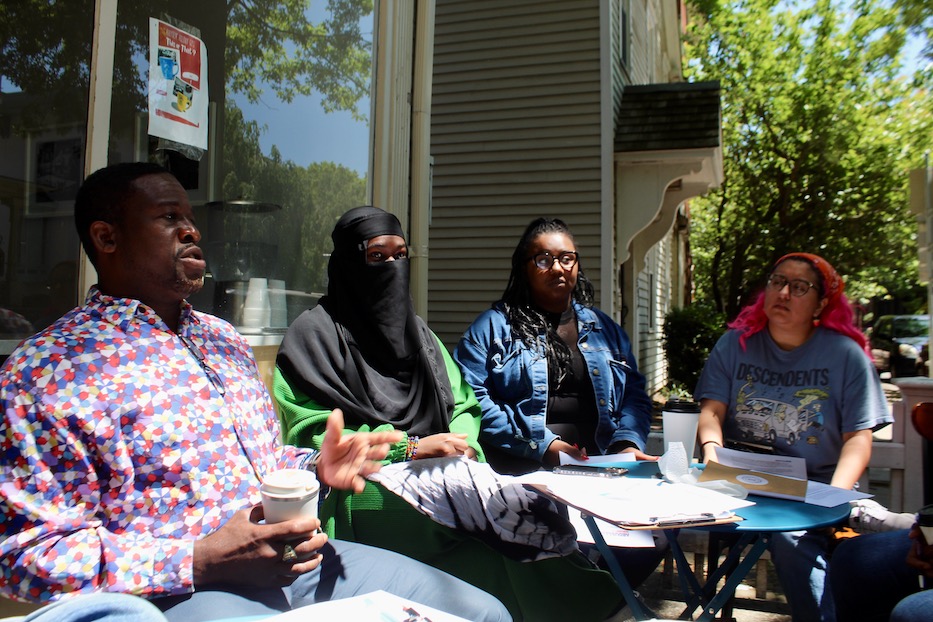
Culture & Community | Politics | Arts & Culture | Wooster Square | Arts & Anti-racism | Mayoral Campaign 2023
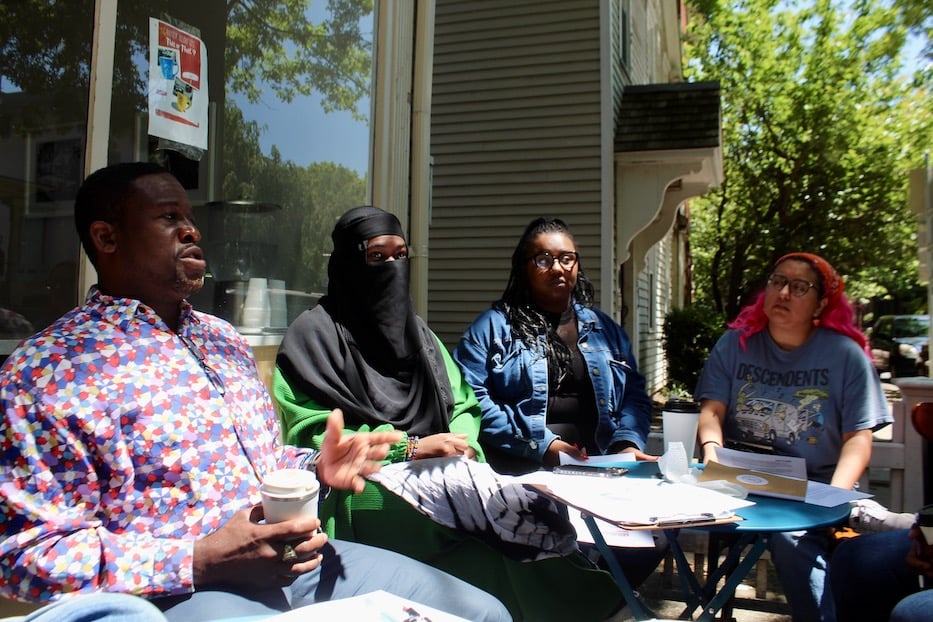
Shafiq Abdussabur, Salwa Abdussabur, Brianna Williams and Ruby Gonzalez Hernandez. Lucy Gellman Photos.
Grow the budget for arts, culture, and tourism in the city to $1 million a year, with programming that jumpstarts workforce development and creative placemaking. Create affordable housing for artists who are being priced out of New Haven. Build spaces of truth-telling, city history and cultural reconciliation, where New Haven can both recognize and begin to reckon with its past.
All of those are part of mayoral candidate Shafiq Abdussabur’s new plan for arts and culture, released Thursday afternoon during a creative roundtable at Kaiyden’s Coffee in Wooster Square. Abudssabur is one of three Democratic challengers seeking to unseat incumbent Mayor Justin Elicker in this year’s September primary.
Surrounded by multimedia artists and small businesses owners, Abdussabur outlined a five-point, multi-pronged plan that jumps from cultural equity and a more robustly funded arts budget to citywide marketing and cultural reconciliation.
Among large-ticket items are a $1 million arts budget for the city, a development team within the Department of Arts, Culture & Tourism, the establishment of affordable housing for artists, and the expansion of economic cultural corridors in several of the city’s historically under-resourced neighborhoods, including those decimated by urban renewal. He has also called for an independent audit of each city department, with no figure attached to that.
Read his plan in its entirety here.
“It’s prioritizing. It’s having a vision. It’s having a plan. It’s having it written down,” he said Thursday, as attendees sipped coffee and tea around two sun-soaked patio tables. “I think it’s about a mayor using their power to make it a priority. The city can’t just say it’s a partner. It has to do the things that’s necessary to create a partnership.”
Thursday’s roundtable included singer/songwriter Briana Williams, Far-Side founder and multimedia artist Ruby Gonzalez Hernandez, Wábi Gallery Owner Kim Weston, Sweet 2 The Soul Owner Shamica Murray, illustrator Michael Pringleton, Black Haven Founder Salwa Abdussabur (who is also Abdussabur’s daughter) and State House Co-Owner Slate Liu-Ballard.
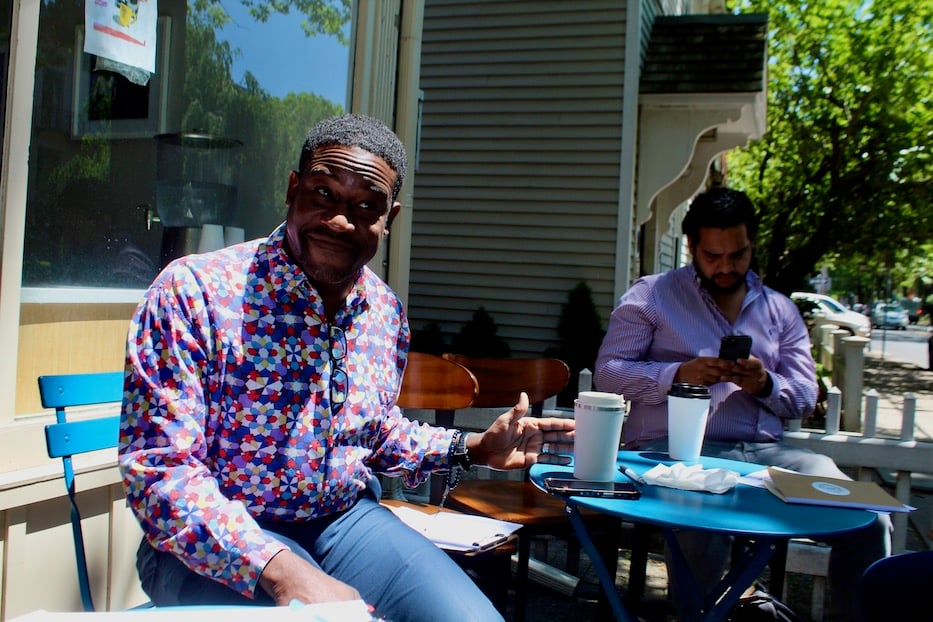
Abdussabur and Campaign Manager Gage Frank.
Abdussabur, who is himself an artist, said that the plan is meant to both address existing needs in the city and establish New Haven as a hub for artists and creatives. Currently, he said, the most consistent concern he hears is the lack of affordable housing and studio space for working artists.
From the beginning of the roundtable, attendees both jumped in to ask questions and listened carefully to what Abdussabur, who worked for nearly three decades with the New Haven Police Department, had to say. For many at the table, New Haven represents a city full of artistic potential, where they have also been all but priced out.
“How are you going to get to $1 million?” Liu-Ballard, who lives in Hamden but operates a space in New Haven, asked. “We’re not prioritizing arts and culture in this city. That’s what’s happening. Look at the budget.”
Abdussabur and campaign manager Gage Frank pointed to New Haven Festivals, the not-for-profit arm of the Department of Arts, Culture & Tourism. Unlike some other city departments, he said, having a 501(c)(3) within arts and culture allows the division to raise funds through grants, public-private partnerships, and corporate donations. What if, he asked, developers had to dedicate a minimum percentage of their total project budget to arts and culture?
“I believe personally, having done contracting, if you come and you’re gonna build something in the city, even though you’re doing it with your private money, you’re using my city services to make a profit in my city,” Abdussabur said. “But I’m not charging you for that profit?”
He looked to the recent construction at 101 College St., where city officials successfully pressed Winstanley Enterprises to contribute $500,000 to a new “Together We Grow” community development fund. Of that, $200,000 is now part of a scholarship fund for New Haven high school students interested in biotech and bioscience. One of the first recipients, Laila Mohammad, is a senior at Hill Regional Career High School.
If that model already exists, he said, why not harness it for arts and culture? In Connecticut, the creative sector comprised $10.1 billion, or 3.4 percent, of the state’s gross domestic product in 2021, according to the U.S. Bureau of Economic Analysis and National Assembly of State Arts Agencies. For a city department that currently receives $350,647 of New Haven’s $662.7 million general fund budget, it’s a way to bring in new funds.
“Every contractor comes in, you can deal with those developers right up front, and have a place where that money specifically goes, such as here,” he said. “And that way, it doesn’t compete with the money that the arts [and arts organizations] is already competing for … What I’m suggesting is there’s additional money that’s out there.”
Murray, a Newhallville-based theatermaker, creative writer and dramatic coach who also homeschools her children, pivoted to the need for affordable housing and artist space in the city.
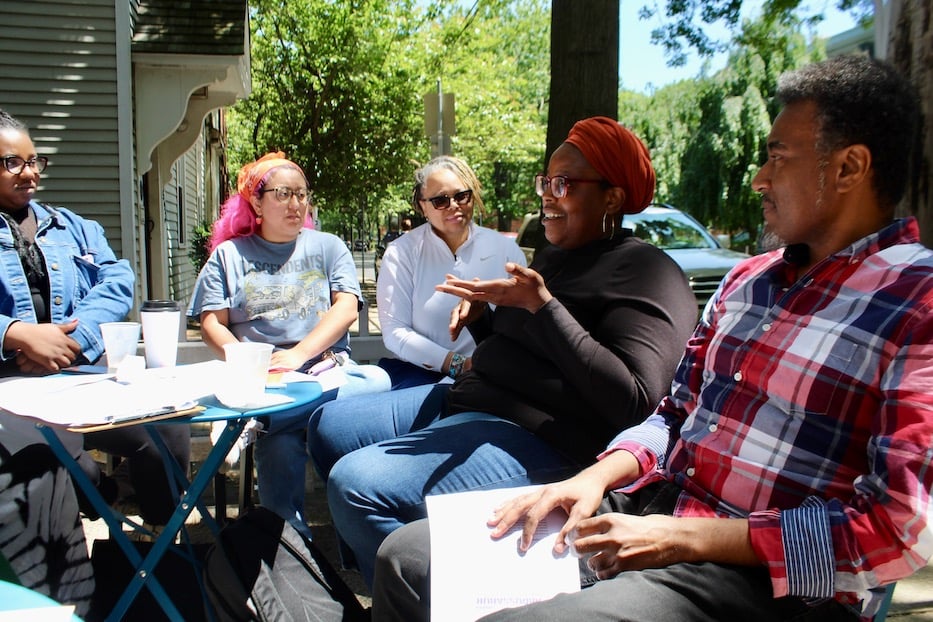
Briana Williams, Ruby Gonzalez Hernandez, Kim Weston, Shamica Murray, and Michael Pringleton.
When she was originally building her arts nonprofit, Sweet 2 The Soul, she looked at spaces across the city trying to find something. “I couldn’t find any cracks or holes in New Haven” where the business might fit, she said. Instead, the only space she could afford was in Branford. She was delighted to open, but sad to be outside of her city.
“You have to have subsidized housing for artists,” Abdussabur said. “When they don’t have housing, when they can’t pay their bills, it just impacts your creative spirit.”
“Period!” Murray said. “It kills it.”
“We have to make housing based on what people can actually afford right now,” he continued. “You have to go to people and talk to people and talk to artists and say, ‘What can you afford right now?’”
“Thirty-five cents!” Murray joked, drawing deep laughter from every corner of the table. “Free!”
He looked to Read’s Artspace, a $14.1 million Bridgeport-based development that went up in 2004, as a working example of affordable housing for artists. Currently, Read’s has 61 work-live units, which range from one to three bedrooms.
According to a 2022 rental application from Millennium Real Estate Services, which manages the property, rent ranges from $333 to $830 per month for a one bedroom, $405 to $1,000 per month for a two bedroom, and $1,025 to $1,150 per month for a three bedroom, all depending on annual household income.
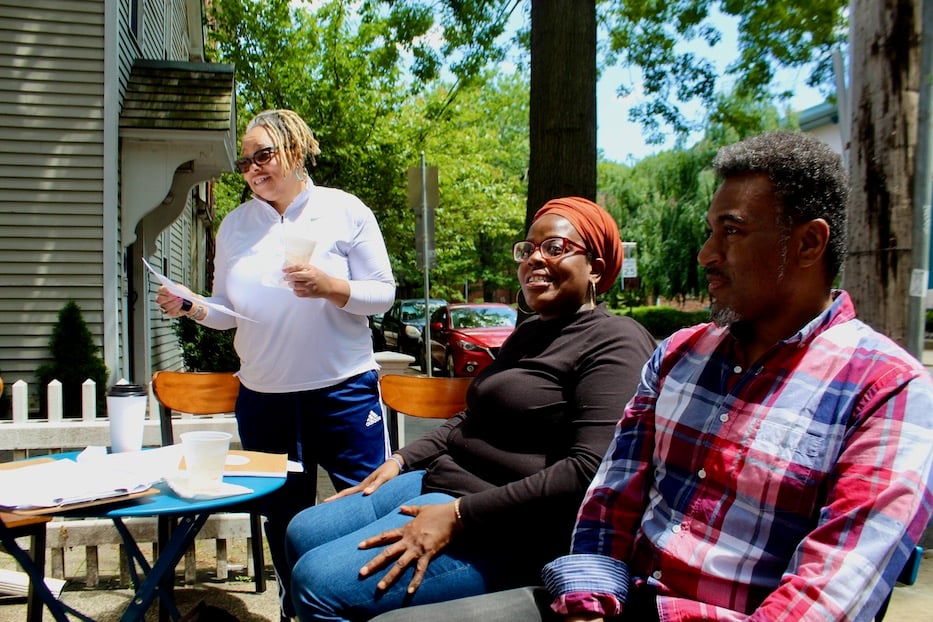
Abdussabur did not mention recent plans for Fair Haven’s long-empty Strong School, where the city has tapped Pennrose, a developer that specializes in affordable housing, to build 58 fixed-income units and a community specifically designed for artists and creatives. According to an interview in the New Haven Independent last November, city officials said that 48 of the 58 apartments “will be reserved for renters making between 30 and 60 percent of the area median income.”
“Listen,” he said. “You bring in, you get a building, you develop real, affordable housing for artists … in return you get a creative person living inside of your city, that returns back to their cultural district of the city. They’re able to do their work, monetize their work, and hold on to some of their [work and income]”
Liu-Ballard asked if Abdussabur had thought about a cooperatively owned real estate company, built and run by creatives. In that model, he said, the cooperative buys, owns, and operates the building. “You have a larger community investing in a smaller community that the artists are then, obviously, investing in the larger community through their art.”
Murray said she thinks about that model frequently when she passes “an eyesore” of a vacant building on Bassett Street in her neighborhood. It has been empty since 2013; a plan for a worker-owned laundry co-op died two years ago. The city and the Board of Education now plan on converting that site into the next home for New Haven’s adult education program.
“I’m like, ‘Why we can’t own this?’” she said. “We would put our money together because we know that our grandchildren would own something in this community. Nothing is feeding the world like the arts. Nothing. Zero. Zilch.”
Abdussabur pointed to such a project, in a chronically under-resourced neighborhood, as potentially transformative for the entire area. If the building could become an arts center and space for after-school programming, he said, economic development and foot traffic would follow.
Salwa Abdussabur shifted gears to a reinvestment that she would like to see in the city’s still-nascent Cultural Equity Plan. When she left New Haven for L.A. several years ago, she felt like “there was nothing for me” in the city. After the pandemic forced her to move back, she dedicated herself to helping the city’s cultural landscape thrive.
“There’s no reason in the world why New Haven, why the community, can’t have culture and arts be [at] the forefront of what we do, and be funded and supported,” she said. “And give it infrastructure.”
Abdussabur noted that part of his commitment, if elected, would include implementing the plan as a piece of city policy. Among initiatives outlined in the plan, he said, that includes a commitment to wealth redistribution, tapping more artists for construction and infrastructure projects in the city, and bringing direct support for the arts into neighborhoods well beyond Downtown New Haven.
Abdussabur’s arts and culture platform also proposes bringing back the $75,000-per-cohort Creative Workforce Initiative (CWI), a workforce development program that places artists and creatives with organizations where they can build specific skill sets. Although the department was able to pilot the CWI last year, with funds from the National Endowment for the Arts granted to the Arts Council of Greater New Haven, it has not yet secured the funds to replicate it going forward.
It’s programs like that that allows artists to practice professionally and make a living doing it, he said. He reflected on his own career as a professional artist, which he left when he had his first son and needed a more reliable source of income. After he had joined the New Haven Police Department, he was surprised to be making enough money to support his family and keep his original work.
Gonzalez Hernandez, who launched Fair-Side earlier this year, asked Abdussabur if he could say more about the “spaces of cultural reconciliation” that he has proposed in his platform. As a lifelong resident of Fair Haven, she said, she’s seen firsthand how little New Haveners know about the artists, makers and storytellers in their own neighborhoods.
Abdussabur dipped instantly into local history, from William Lanson’s role in building out Long Wharf and the Farmington Canal to the day Muhammad Ali boxed at the corner of Webster Street and Dixwell Avenue. He noted how little New Haven history students learn in the city’s public schools. As mayor, he said, he’d like to see pieces of public art commemorating that legacy across the city.
Campaign Manager Gage Frank added that he sees very little dedicated to the histories of Native displacement in New Haven. Wooster Square, for instance, is on Quinnipiac and Wappinger land.
“It’s having the city tell those stories,” Abdussabur said. “It is us remembering who we are.”

